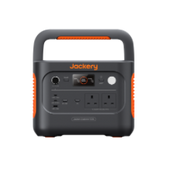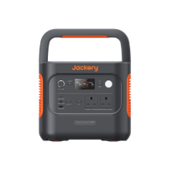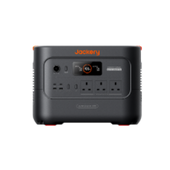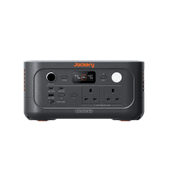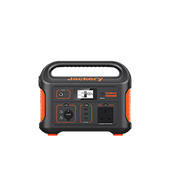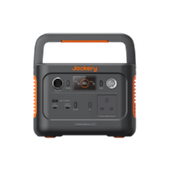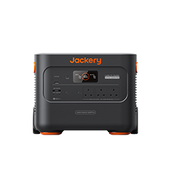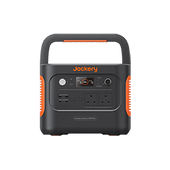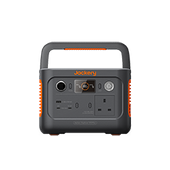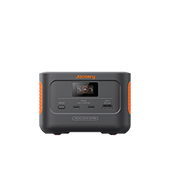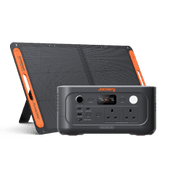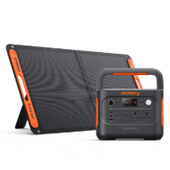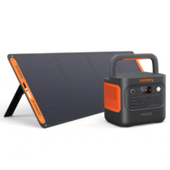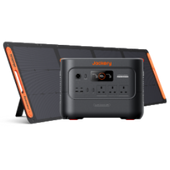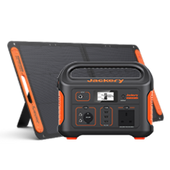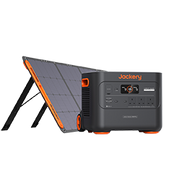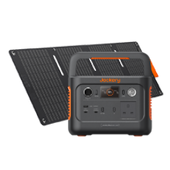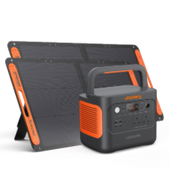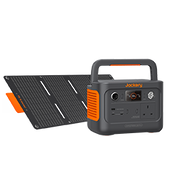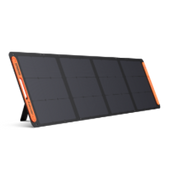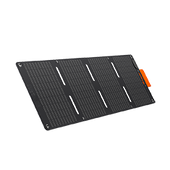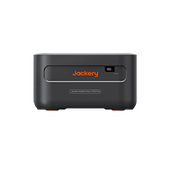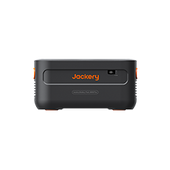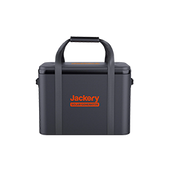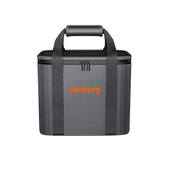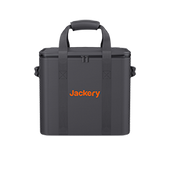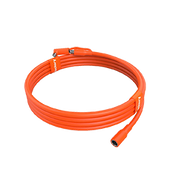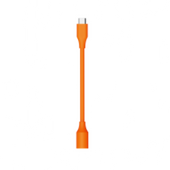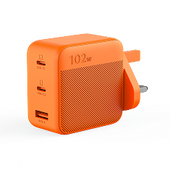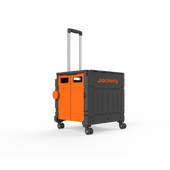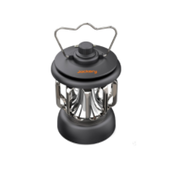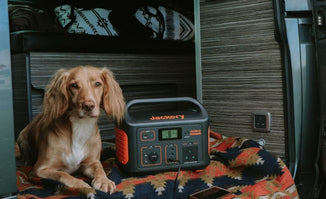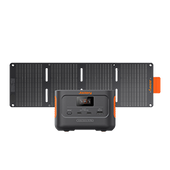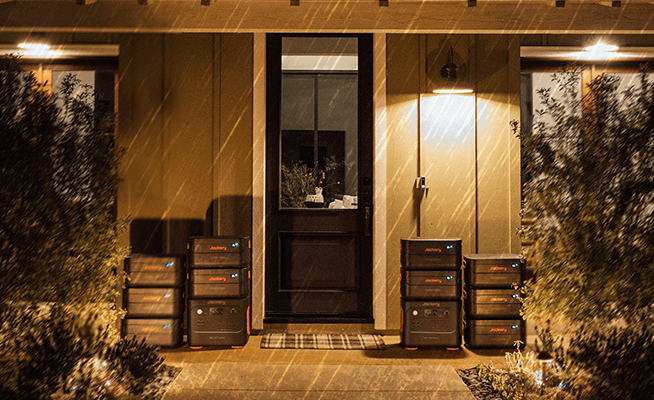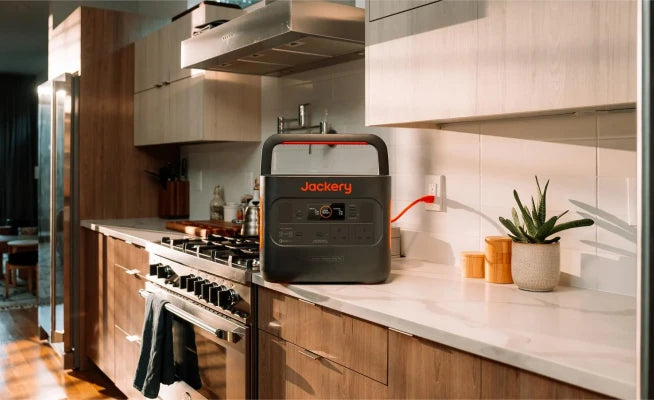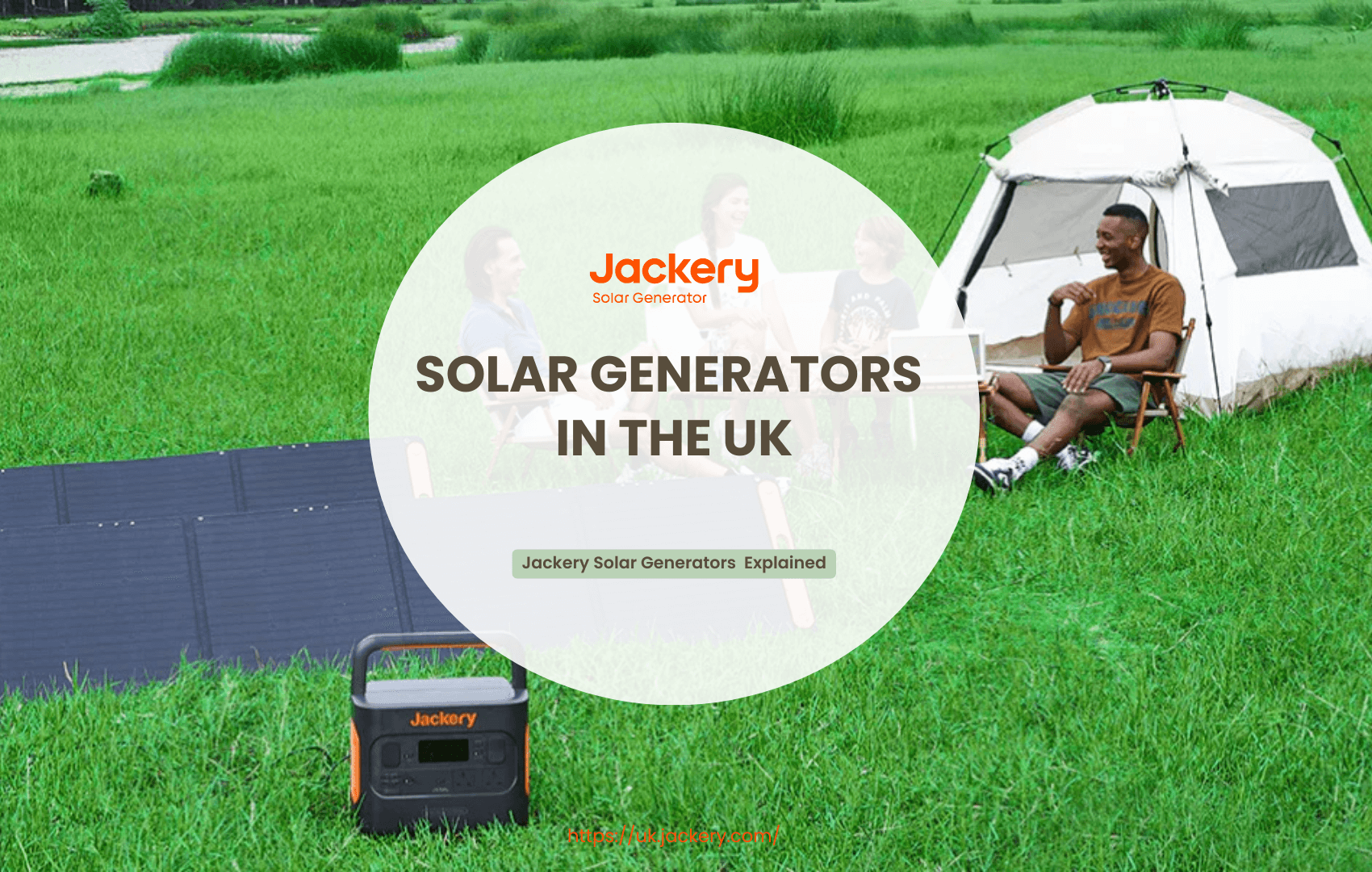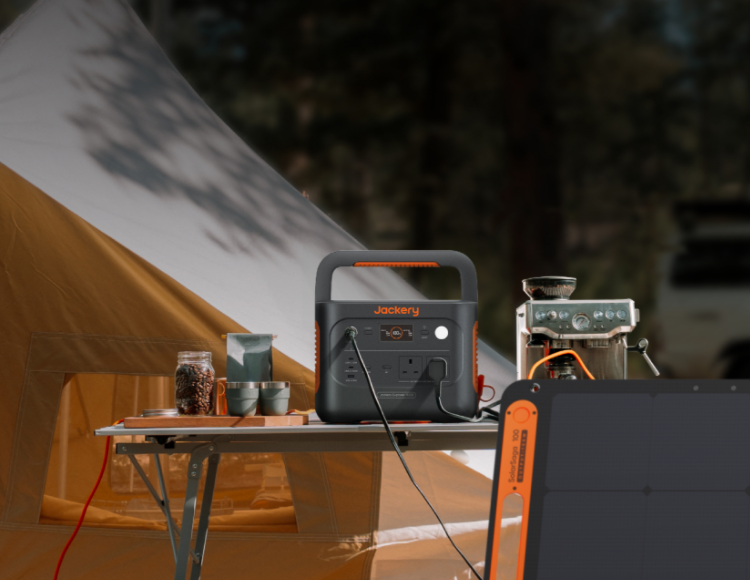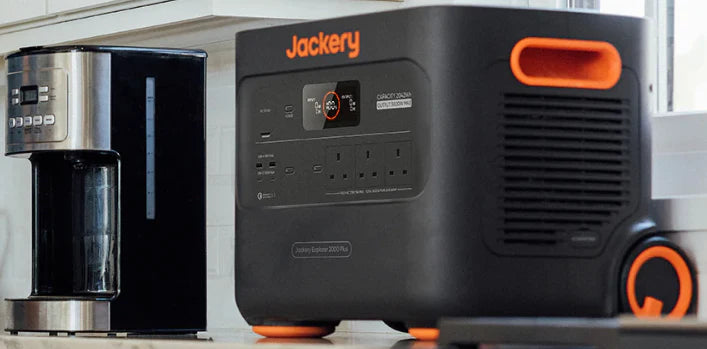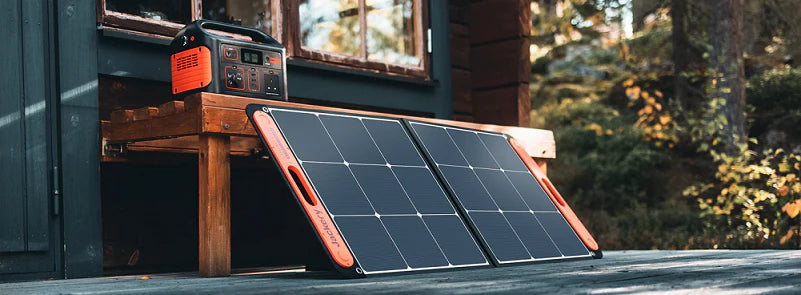Solar generators are unique because they are more environmentally friendly than traditional ones. This paves the way for a more sustainable and carbon-friendly future. Solar generators are the best way to get electricity without pollutants.
Whether you want to explore the outdoors, go camping, take a boat trip to enjoy time on the water, or even reduce your reliance on the UK national grid for electricity. However, many people in the UK still wonder if solar generators are worth it.
This guide explores the basics of solar generators and analyses the doubts about whether they are worth it in the UK. We will also introduce Jackery Solar Generators as your ideal companion for camping, caravanning, off-grid living, or home backup.
|
Key Takeaways: |
|
- Unlike conventional generators that use fossil fuels, solar generators use the sun's energy to provide clean, renewable energy. - The basic working principle of solar generators is to convert sunlight into electricity when it hits a solar panel, which can power various devices. - Choosing a suitable solar generator requires careful consideration of multiple aspects, such as conversion efficiency, battery types, portability, budget, and more. - We recommend Jackery Solar Generator 1000 Plus or 2000 Plus for charging appliances with solar energy. |
What Is a Solar Generator?
Unlike conventional generators that use fossil fuels, solar generators use the sun's energy to provide clean, renewable energy. Solar generators, such as Jackery Solar Generators, are widely used as emergency backup power sources and can also be used for sailing, RV travel, and camping trips.
They provide a sustainable solution for various power needs, from home backup power to power for off-grid travel in remote areas. A complete solar generator typically consists of four core parts.
|
Components |
Function |
|
Solar Panels |
Convert solar radiation into electrical energy. |
|
Charge Controller |
Ensure that the battery can work in the best condition. |
|
Battery (Power Station) |
Store the electricity generated by solar panels. |
|
Inverter |
Ensure that the solar generator can provide a stable and reliable power supply. |
How Does A Solar Generator Work?
The basic working principle of solar generators is to convert sunlight into electricity when it hits a solar panel, which can power various devices. The working principle of solar generators is divided into the following three processes:
Solar energy is generated by the photoelectric effect, which occurs when sunlight hits the solar panel's photovoltaic (PV) cells. This process is the basic principle of solar energy conversion.
Under the electric field inside the panel, electrons and holes are separated and move to the two poles of the panel, respectively, thereby generating voltage and current, realising photoelectric conversion.
Only some of the electricity generated is used immediately. Excess electricity is stored in batteries through a charge controller. The inverted AC power can be directly supplied to local loads or connected to the grid to power a wider area.
How Does A Jackery Solar Generator Work?
A solar generator functions by harnessing solar energy through solar panels and storing it in a solar battery or portable power station. Jackery Solar Generators integrate Jackery Solar Panels and Portable Power Stations to transform solar energy into electricity. The integrated inverter in the power station transforms direct current (DC) to alternating current (AC), enabling it to power equipment indoors and outside.

Jackery Solar Generators utilise an advanced BMS system and a pure sine wave inverter to offer 12 layers of protection for charging devices. The unparalleled cooling system and up to nine temperature sensors guarantee an exceptional 30% dissipation efficiency rate. The product's 94V-0 fire rating and UL standard drop design indicate exceptional durability.
Solar Generators VS. Gas Generators
Solar generators are a clean, renewable alternative that generates electricity from sunlight, resulting in minimal emissions. In contrast, traditional generators are powered by fossil fuels such as gasoline or propane, creating significant emissions and necessitating fuel operation.
Solar generators are generally more environmentally friendly, portable, and quieter, but their power output may be restricted by sunlight availability. In contrast, traditional generators can generate higher power. The following are the comparisons of different types of generators.

Solar Generator
Solar-powered generators are indispensable resources when camping in the forests due to their zero-noise operation and environmental friendliness.
In contrast to gas generators, once your solar generator is installed (i.e., the solar panels are orientated appropriately towards the sun), you can disregard it. Refuelling is unnecessary. The longer it remains in the sun, the more it accumulates.
Pros of Solar Generators:
In essence, the utilisation of a solar generator results in the utilisation of free energy from the sun, as opposed to the consumption of expensive, polluting fossil fuels. In contrast to most conventional fuel or gas generators, solar generators are devoid of moving elements and do not rely on liquid fuel.
While noise pollution is irritating, gas-powered generators contribute to climate change and generate air pollution. Many heavy-duty gas-powered generators can be pretty weighty, with some models weighing as much as 250 pounds.
Cons of Solar Generators:
Solar generators cannot produce energy on cloudy or damp days or at night. The size of the battery and inverter restricts the generator's capacity to generate power. The acquisition and installation of solar generators can be costly.
Gas Generator
A gas generator is a device that generates electricity by utilising fuel, such as petroleum, natural gas, or propane. Mechanical power is generated by the combustion of fuel in an engine. This force then drives the alternator, a generator component that generates electricity.
Pros of Gas Generators:
Gas generators are a more cost-effective entry point for backup power solutions, as their initial costs are substantially lower than those of solar alternatives.
In contrast to solar systems, gas generators for residential use operate consistently regardless of the time of day or weather conditions. This dependability guarantees that you will have access to electricity when required, irrespective of whether it is a sunny afternoon or a stormy midnight.
Gas generator systems provide consistent, predictable power without the fluctuations prevalent in renewable energy systems. This consistent output renders them dependable for operating sensitive electronics and maintaining stable power for critical appliances.
Cons of Gas Generators:
Petrol generators produce carbon monoxide and other harmful emissions, which can be fatal in enclosed spaces. Due to these toxic fumes, indoor operation is rigorously prohibited, necessitating careful placement away from windows, doors, and ventilation systems to guarantee safety.
In addition, gas generators necessitate frequent refuelling and have a restricted gas runtime, typically ranging from 4 to 10 hours of moderate use on a single cylinder.
Due to their mechanical nature, gas generators necessitate routine maintenance, including replacing oil filters and spark plugs. If you are not mechanically inclined, this can be both time-consuming and expensive in the long run, with costs estimated to reach as high as £550 annually.
What Size of a Solar Generator Do I Need?
Choosing the right size solar generator is key to ensuring efficient use of solar energy. So, how do you choose a solar generator of the right size?
Step 1: Identify the Usage Scenario
Suppose it is mainly used for home power supply. In that case, you need to consider the family's daily power consumption and whether there are high-power appliances like air conditioners. Portable solar generators are more suitable for outdoor activities or camping. Such generators are usually light and easy to carry, supporting small appliances such as mobile phones, laptops, etc.
Step 2: Determine Power Requirements
The size of the solar generator you need usually depends on your power consumption. You can calculate your power requirements by calculating the wattage required for the solar generator's appliances.

Please determine the starting and running power requirements of the appliances and equipment you plan to plug into the generator. The power information is usually found on the appliance label. The following table shows the starting and running power information of some common appliances in the UK.
|
Appliances |
Running Wattage |
Starting Wattage |
|
Washing Machine |
1200W |
2000W |
|
Refrigerator |
700W |
1200W |
|
Light Bulb |
25-60W |
0W |
|
Microwave |
750W |
0W |
|
TV |
200W |
0W |
|
Coffee Maker |
550-1000W |
0W |
|
Blender |
300W |
800W |
|
Laptop |
50-200W |
0W |
|
Projector |
300W |
0W |
Step 3: Calculate the Running & Starting Wattage of the Appliances
Add up the running wattage of the appliances you plan to use to get the wattage your solar generator needs.
Here is an example:
1000W (Microwave) + 900W (Toaster) + 75W (Light) + 300W (Computer) + 500W (TV) = 2775W
The appliance with the highest starting power will be your peak power demand, so determine it beforehand.
For example, if you add a refrigerator with a starting power of 2200W (running wattage of 700W) to the example in Step 2, the maximum running power of the solar generator you need is 2200W.
Step 4: Calculate the Combined Power Needs
Add the running and starting power of all the devices you need to power, and you will have a rough idea of the generator size you need.
For example, to calculate the solar generator's total wattage in Step 3, add the refrigerator's starting power to its total running power.
2775W+2200W= 4975W
The data mentioned above are estimates, and the power consumption of your appliances may vary. But remember that to be on the safe side, you should buy a solar generator with a storage capacity that is more than your total power requirements. So, to avoid overloading the generator, purchase a five-kilowatt solar generator.
Step 5: How to Determine What Size of a Jackery Solar Generator I Need
As mentioned above, the Jackery Solar Generator is one of the excellent solar generators on the market. The Jackery Portable Power Station is 30% lighter than comparable products with equivalent capacity, rendering it ideal for excursions. Integrating a portable power station with a foldable, lightweight magnetic solar panel enables the solar generator to meet the electrical requirements of most equipment while on the move.
The Jackery Solar Generators range from 99Wh to 12 kWh; you can choose one based on your power needs. There is a formula to calculate the working hours by using Jackery Solar Generator to charge appliances:
Working Hours = Jackery Portable Power Station Capacity*0.85/Appliance Wattage
For example, charging a 200W computer with Jackery Solar Generator 1000 Plus (1264Wh) will work 5.4 hours (1264*0.85/200). Learn more about this generator in the following section.

Jackery Solar Generators Explained
The Jackery Solar Generator is exceptionally robust and enduring. SolarSaga Solar Panels operate effectively within a temperature range of -10 to 65C, whereas the power station functions optimally between -10 and 40C.
Jackery's comprehensive solar power system is recognised for its straightforward installation capabilities. The solar generator requires one minute for setup, and its one-button activation system facilitates user operation. Jackery's compact and extensive solar generators can fulfil your power demands with minimal noise (30 dB) regardless of your charging requirements.
|
Appliances |
Working Hours |
|
|
Jackery Solar Generator 1000 Plus (1.25-5 kWh) |
Jackery Solar Generator 2000 Plus (2-12 kWh) |
|
|
Refrigerator (700W) |
1.5-6.1H |
2.4-14.6H |
|
Computer (200W) |
5.4-21.3H |
8.5-51H |
|
Projector (300W) |
3.6-14.2H |
5.7-34H |
|
Lighting (50W) |
21.4-85H |
34-204H |
|
Portable Heater (1000W) |
1.1-4.25H |
1.7-10.2H |
Jackery Solar Generator 2000 Plus
Jackery Solar Generator 2000 Plus is the most suitable generator for off-grid living or home backup. It is a solid portable power solution that delivers outstanding performance. With its impressive capacity and powerful output, this device can support the operation of essential appliances for weeks, even certain large appliances, such as your refrigerator, portable heater, kettle, etc.

- Expandable Powerhouse for Your Appliances: The Jackery Solar Generator 2000 Plus enables the addition of extra battery packs, increasing the capacity from 2 kWhto an impressive 12 kWh, thereby significantly satisfying your power needs. This solar product has a remarkable output of 3000W, providing a 30% higher rated power than other 2 kWh solar products.
- Safe to Use with ChargeShield: ChargeShield is Jackery's advanced fast charge technology, featuring 62protective mechanisms, 12 protective algorithms, and four types of physical safety protection. This technology uses a unique stepped variable-speed charging algorithm to enhance safety and extend battery pack lifespan by 50%.
- Higher Resistance & Reliability: The Explorer 2000 Plus stands out as a groundbreaking add-on battery pack that offers the convenience of recharging through solar panels. This feature increases versatility, boosts charging efficiency, and shortens charging time. Also, it can be taken indoors safely compared to gas generators.
Jackery Solar Generator 1000 Plus
Jackery Solar Generator 1000 Plus combines SolarSaga 100W solar panels with Explorer 1000 Plus. The Explorer 1000 Plus is the same as the Explorer 2000 Plus, which is the expandable LiFePO4 battery to be added to a 5 kWh capacity. If Jackery Solar Generator 2000 Plus is for charging your appliances for a few weeks, this solar generator is for charging for several days.

- Excellent Power Output: The Explorer 1000 Plus power station boasts an excellent 1264Wh long-lasting LiFePO4 battery and a 2000W full-power pure sine wave inverter, supplying almost all required power. Adding up to three additional battery packs will remarkably increase its capacity to 5kWh.
- Expandable Powerhouse: Adding up to three extra battery packs lets Jackery's exclusive technology boost the Explorer 1000 Plus capacity from 26kWh to5kWh. Moreover, it has a maximum output of 2000W, 20% more than usual 1kWh LFP generators.
- Higher Solar Conversion Rate: The Jackery SolarSaga 100W Solar Panel boasts a solar conversion rate of up to 25%; it is optimally designed for outdoor use and unforeseen power interruptions. The solar panel weighs about 8 lbs, is lightweight, foldable, and equipped with a convenient carry handle, enhancing its portability.
How to Choose a Solar Generator in the UK?
With the increase in environmental awareness and the advancement of technology, more and more families have favoured solar generators as a clean and renewable energy solution. However, choosing a suitable solar generator has become a problem for many people. Here are some key factors to help consumers make wise purchasing decisions.
Photoelectric Conversion Efficiency
The photoelectric conversion efficiency of a solar generator directly affects its power generation capacity. The photoelectric conversion efficiency of a solar panel mainly depends on the material and technology of the solar panel. Common types include monocrystalline silicon, polycrystalline silicon and amorphous silicon.
|
Solar Panel Types |
Advantages |
Disadvantages |
|
Monocrystalline silicon solar panel (18% to 24%) |
Higher photoelectric conversion efficiency Good stability Long life Beautiful appearance |
Complicated production process Higher cost |
|
Polycrystalline silicon solar panel (Around 16%) |
Low cost Good stability Environmental protection and energy saving Wide application |
Slightly lower conversion efficiency Poor aesthetics Short lifespan |
|
Amorphous silicon thin film solar panel (Around 10%) |
Good low-light performance Low cost Light and thin Strong environmental adaptability |
Low conversion efficiency Poor stability Short service life |
Battery Types
Storage batteries are a key component in ensuring a continuous and stable electricity supply generated by solar generators. The following are several types of storage batteries commonly used in solar generators:
|
Battery Type |
Advantages |
Disadvantages |
|
Lead-acid battery |
Low-cost Mature technology High reliability Good temperature tolerance |
Shorter lifespan Regular maintenance Lower energy density Occupies more space |
|
Lithium-ion battery |
High energy density Long cycle life No maintenance required Small overall volume and weight Low self-discharge rate |
High cost No large-scale application |
|
Lithium iron phosphate battery |
High-safety Long cycle life Good environmental adaptability Stable power output |
Low energy density High price |
Functional Requirements
Solar generators offer various functions, such as built-in battery performance, type and specification of plug-in interface, supply voltage, current, power, etc. It would help if you ensured that the selected generator's functions met the power requirements of some of your electrical appliances.
Portability
A lightweight and easy-to-carry solar generator is more suitable for users who often camp or engage in outdoor activities. However, size and weight are relatively less critical if the generator is mainly used for home or fixed power supply.
Budget
Finally, budget is also an essential factor to consider when purchasing a solar generator. The initial investment includes equipment purchase and installation costs, while the operating costs include maintenance, insurance and other expenses. When making a budget, you need to consider these costs comprehensively and understand the government's solar subsidies and preferential policies to reduce the pressure of initial investment.
Brand and After-sales Service
Brand and after-sales service are important factors when choosing a solar generator. Well-known brands usually mean better product quality and after-sales service, which can provide stronger protection for your use.
Are Solar Generators Worth It in the UK?
The UK is known for its commitment to sustainable development and reducing carbon emissions, providing a suitable environment for solar generators to flourish. However, whether a solar generator is "worth it" depends mainly on your needs and the specific circumstances of your situation. Below, we will analyse whether solar generators are worth investing in the UK. First, let's explore the advantages and disadvantages of solar generators.
Advantages and Disadvantages of Solar Generators
In the UK, solar generators have significant advantages and disadvantages that must be considered.
Here are the advantages of solar generators in the UK:
- Environmental benefits (reduced carbon footprint, noise, air pollution)
- Enhance independent power supply capabilities
- Reduce electricity bill costs
- Low maintenance costs
- Permanent investment
- Policy support
Here are the disadvantages of solar generators in the UK:
- High upfront costs
- Greatly affected by weather
- Long charging time
- Limited power supply capacity
- Government subsidy policies may change
Are There Any Incentives for Solar Generators in the UK?
There are some incentives for buying solar generators in the UK designed to promote renewable energy, reduce your carbon footprint and help reduce energy costs for households and businesses. Here are some of the main incentives:
Feed-in Tariff
The Feed-in Tariff is a UK government scheme that pays households and businesses that install solar power systems for every kilowatt-hour of electricity they produce. Although this policy has now ended, it is still valid for systems installed before the end of the policy.
Smart Export Guarantee
This policy requires suppliers to purchase excess electricity from solar power systems at market prices.
Green for installation and maintenance costs Grant
The Green Homes Grant scheme provided households with grants of up to £5,000 to install energy-saving measures, including solar power systems. This scheme has ended, but the government may introduce a similar one.
Using solar generators in the UK has significant advantages and challenges, such as high upfront costs. In addition, the UK government currently has many incentives to encourage households and businesses to purchase and install solar generators. However, users should consider their needs, economic conditions, policies and regulations when installing solar generators in the UK.
Solar Generators in The UK FAQs
The following are the frequently asked questions about the solar generators in the UK:
- Is it worth to get a solar generator?
Solar generators have received considerable attention in recent years. However, whether it is worth buying one is a complex answer; it must be comprehensively considered based on its advantages and disadvantages.
In addition, whether a solar generator is worth buying depends on your needs. A solar generator is a good choice if you live in a remote area, often face power outages, or have high environmental protection requirements. It can provide stable and clean electricity while reducing dependence on traditional power grids. In short, whether a solar generator is worth buying must be comprehensively considered based on specific circumstances (such as electricity demand).
- Can a solar generator power a house?
Solar generators are widely used in many fields, but can they power a house? In theory, yes, but a comprehensive assessment must be made based on electricity demand, geographical location, climate, and economic conditions. By adequately configuring solar panels and battery energy storage systems and ensuring proper use and maintenance, solar generators are likely to become an important power source.
- What can a 3000-watt solar generator run?
A 3000-watt solar generator is a practical power source that meets most UK homes' power needs and prevents power outages. Most household appliances are rated at less than 1800 watts, which means that a 3000-watt solar generator is sufficient to power many appliances. A 3000-watt solar generator can typically power the following appliances and equipment:
Household appliances: TVs, refrigerators, air conditioners, fans, lights, microwaves and blenders.
Outdoor equipment: lighting systems, electric lawnmowers, trimmers, etc.
Medical equipment: CPAP machines, refrigerators and oxygen concentrators.
Final Thoughts
Solar generators combine green values with modern technology and are worthwhile for those who care about the environment and can save money in the long run. Additionally, those who enjoy camping, hiking, or living a non-traditional lifestyle can use solar generators, like Jackery Solar Generators, to run home appliances. In short, when choosing whether to install a solar generator, consider your needs and economic status.

